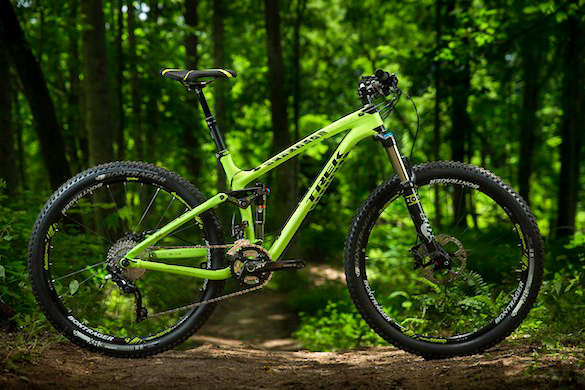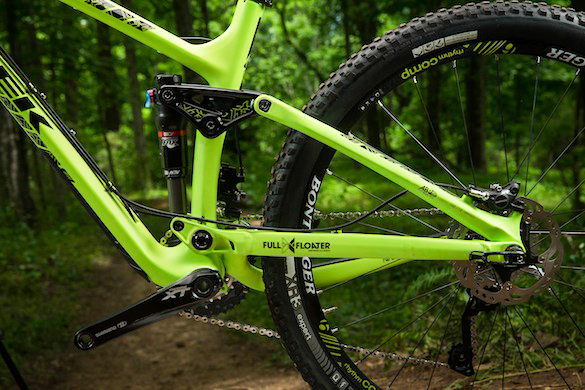Inside Line: Trek introduces new Fuel EX 27.5 with F1 derived Re:aktiv shock
Originally posted on June 13, 2014 at 2:39 am
Trek hasn’t shied away from developing proprietary suspension products in its search for better performance. About five years ago, the Dual Rate Control Valve (DRVC) air spring system appeared on Trek’s full suspension bikes, and has remained part of its suspension designs ever since.
About the same time, Trek started talks with Penske Racing Shocks through a fortunate father-son connection, the father being a well-respected NASCAR engineer, and the son being a frame engineer with Trek.
I knew the Penske name had something to do with racing, but I was mostly familiar with the big yellow rental trucks. Penske is a whole other ballgame supplying high-end, bespoke suspension solutions to the fastest motorsports racing teams in the business, including six of thirteen F1 teams.
There are a few mountain bikers on staff at Penske’s Reading, Pennsylvania, “skunk works” where most of the suspension design takes place. Those riders realized that the “regressive” damping design developed for F1 racing would have some application for mountain bikes, and a partnership with Trek would be a perfect vehicle to deliver it to the mountain bike market.

The only sticking point? Penske isn’t a mass manufacturer. They operate on a high-end, low volume model, and Trek needs a lot of shocks. This is where Fox Racing Shox comes in. Fox partnered with Trek and Penske to fit the new RE:activ damping design into the existing DRCV shock body. Fortunately, there is little to no overlap with in the Fox and Penske motorsports market, and in the end I think the real winner in this three-way partnership will be the consumer.
The idea behind regressive damping is a firm low speed platform for support while pedaling, with a high speed circuit that substantially reduces compression damping and then slowly ramps it back up to gain control of the suspension again, and help prevent bottoming. Trek has been calling this “the nose” as the graphs below illustrate why that name is fitting.

That regression in the middle of the stroke is claimed to “take the tops of the hard hits”, according to Jose Gonzales, head of Trek’s suspension R&D facility in southern California. This helps to keep the wheel in contact with the ground, and prevents any harshness in the mid-stroke as shock transfers from the low to high speed damping circuit.
In theory, this sounds much like the idea behind inertia valve shocks like Specialized’s BRAIN, but Trek claims this shock is completely seamless, with no lag time or initial hard impact needed to get the shock moving.
Trek invited 30 international journalists in Brevard, North Carolina, to ride the new shocks on a fleet of fresh 2015 Fuel EX 9.8 27.5 mountain bicycles, all very new and all very yellow. While part of me was disappointed we didn’t ride some of the gnar this area is known for, these are 120mm trail bikes, and the smoother trails are more in line with how these bikes will most often be used.
I’ve ridden and liked many of Trek’s DRCV equipped bikes I’ve ridden in the past, but was never very happy with the difference in performance between the full open position versus the harsh ride with the platform damping turned on. The new shock seemed to solve this complaint.

I spent the majority of the time in Trail mode, and went out of my way to hit things in the trail, and the suspension seemed to perform as advertised. Plenty of platform to keep the bike settled and pedaling well, but hit something hard enough to get the suspension moving quickly, and the high speed circuit kicked in, the compression damping curve regressed, and the bumps were handled with a finesse most often reserved for a long travel bike.
Since I made the choice to drive down to Brevard, I managed to extract one of the new EX’s from the herd of new bikes to take home with me, so we’ll have a full review soon.

Other changes
Also new is a 27.5 wheeled replacement for last year’s women’s Lush 29er, and a new, wider rear axle standard to equalize wheel stiffness between 27.5 and 29 and create some extra room at the bottom bracket area for bigger chainrings.

Trek sees the women’s bike market gravitating towards the smaller wheel size, making for bikes that are less unwieldy for smaller riders. The same leverage-rate adjusted suspension design carries over, insuring that smaller riders are able to run average air pressures and damping settings in the rear shock. Keeping the shock operating in the middle of its design perimeters is a very good thing for suspension performance.

The new rear axle standard, called Boost 148, is an open source design, meaning it can be adapted by other companies as well. It seems the main complaint Trek was hearing about the Remedy 29 had to do with wheel stiffness versus the 27.5 version. By moving the spoke flanges out 3mm per side, spoke triangulation is increased, resulting in a wheel at least as stiff as a similar 27.5 wheel.

SRAM partnered with Trek to provide a new single ring crank that spaces the chainring over to line up with the wider chain line on the 148 hub. This space also makes room for chainrings up to 38 teeth. Most trail riders are not looking to run 38t rings on a 29er, but Trek’s successful enduro race team is sold on the Remedy 29 as a race bike, and needs to get those big rings on there for faster courses. The new crank only moves the chainring over, via a new spider, so there is no change to the bottom bracket standard. A 150mm rear hub is actually 157mm with the thru-axle, and would require a wider bottom bracket shell.